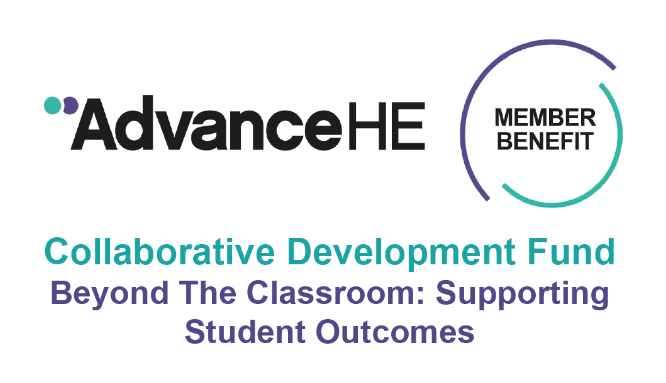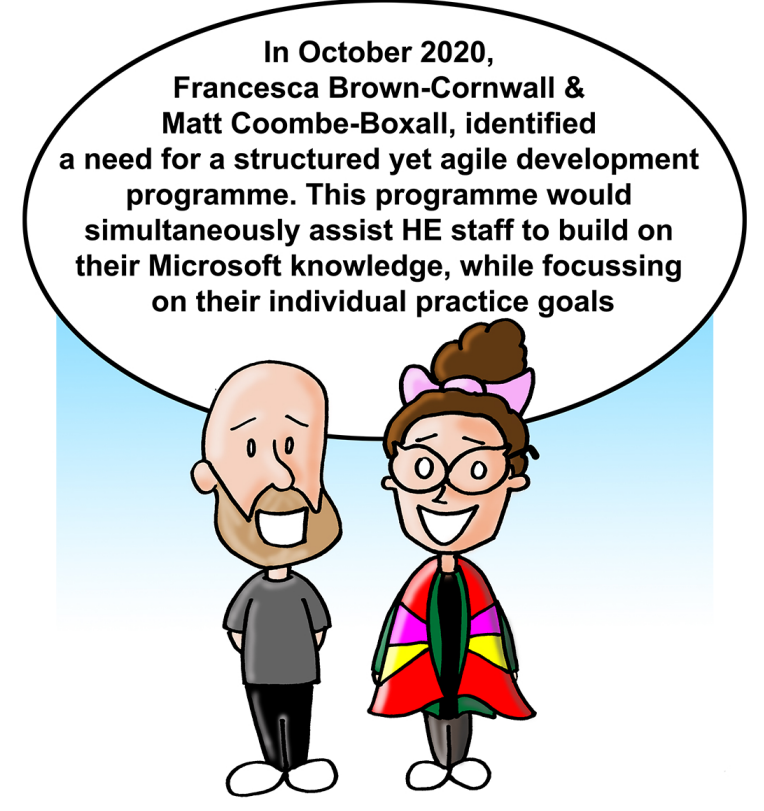
As SCoLPP Innovators Fran Brown-Cornwall @FrankieCornwall and Matt Coombe-Boxall @mcoombeboxall share their experiences of using coaching on Staffordshire University Microsoft Innovative Educator Expert Coaching Programme (known as SUMEC).
This first of its kind staff development coaching programme supported staff towards applying for and obtaining MIE Expert status, whilst simultaneously enabling staff to focus on their own personal goals with using technology to enhance the experience of their learners at the university.
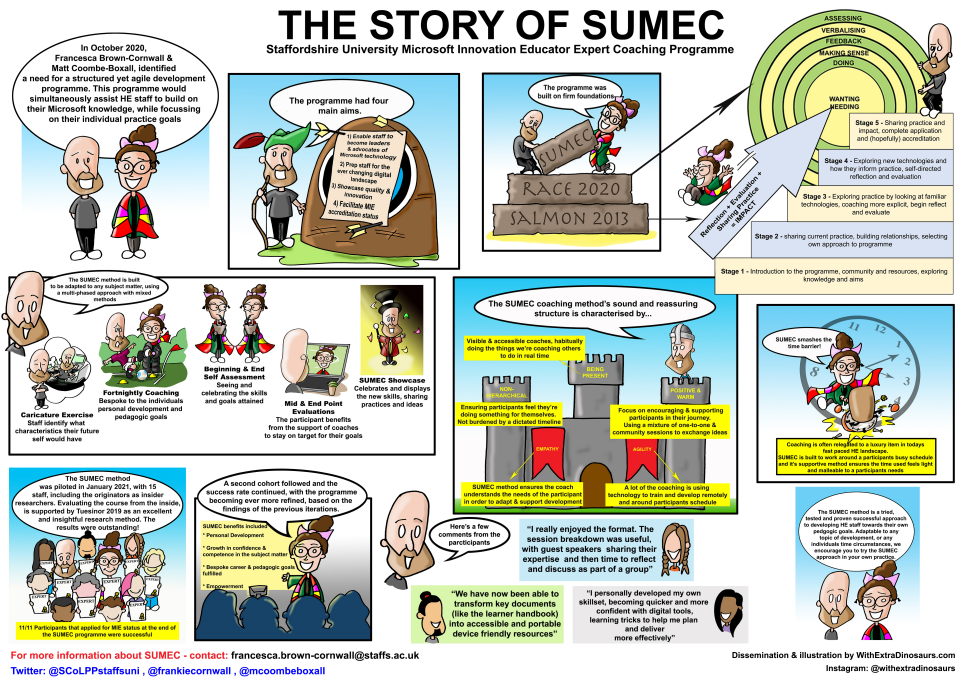
Alongside this blog post, we have summarised our work as a storyboard which can be downloaded by clicking the image on the left.
Digital skills and innovation in teaching is at the forefront of the HE agenda, with JISC (2021) reporting to have a 2030 vision that will see HE providers respond to student feedback which identifies that they appreciate online/digital learning, but that sometimes approaches are unengaging and more fatiguing. For HE staff to maximise on the positive aspects of digital learning, teaching and wider student experience, it is important staff seek to continually improve their digital capabilities to ensure students remain fully engaged and involved. Therefore, it is arguably timely that our SUMEC project combined coaching and digital skills into a single programme.
Coaching Partnership for Digital Development
Instrumental to the inception, development and implementation of the project was the relationship between the two coaches leading the programme, one a learning technologist and another an academic in the Institute of Education at Staffordshire University. Van Allen & Katz (2023) highlight that educators must adopt qualities in keeping with open education to support the evolution of technological, pedagogical and content for their learners. Breaking down the possible silos between academic and professional service staff in a continuing professional development environment in Higher Education (HE) is important for the student learner experience, therefore the programme welcomed social interactions across services, subjects and departments which helped to reconstruct teaching, collaboration and communication using technology (Basdogan, Birdwell and Harris 2022).
According to the European Mentoring and Coaching Council (2020) coaching and mentoring is an approach which can be used to help learners accelerate their careers, their development and successes. The Department for Education (2020) acknowledge the significance of coaching and mentoring within education and signpost the education sector to resources which encourage an ethos of coaching and mentoring in and amongst colleagues in educational establishments. Race (2020) highlights that purposeful coaching is a useful component is effective learning in Higher Education and reminds us that to be a principal fellow of the HEA an individual must demonstrate strategies for supporting and promoting others giving mentoring and coaching as explicit examples of such effective practice. Therefore, it is identifiable that programmes of CPD whereby coaching is the vehicle are desirable in education and specifically in HE CPD.
The aims of the programme
The six-monthly programme provided an opportunity to build a lasting community of innovative educators at the University, whilst seeking to make ready its participants for the professional Microsoft accreditation. Whilst there was naturally a focus on how Microsoft Technologies can be used to develop teaching and learning practice by creating immersive and engaging learning activities within the programme, the experience was highly reflective, evaluative and collaborative, recognizing commitments of staff to innovative practice, digital advancement and building connection. The goal of the SUMEC programme was to coach participants towards completion of the MIE Expert application, helping them to obtain evidence of their impact using Microsoft Technologies.
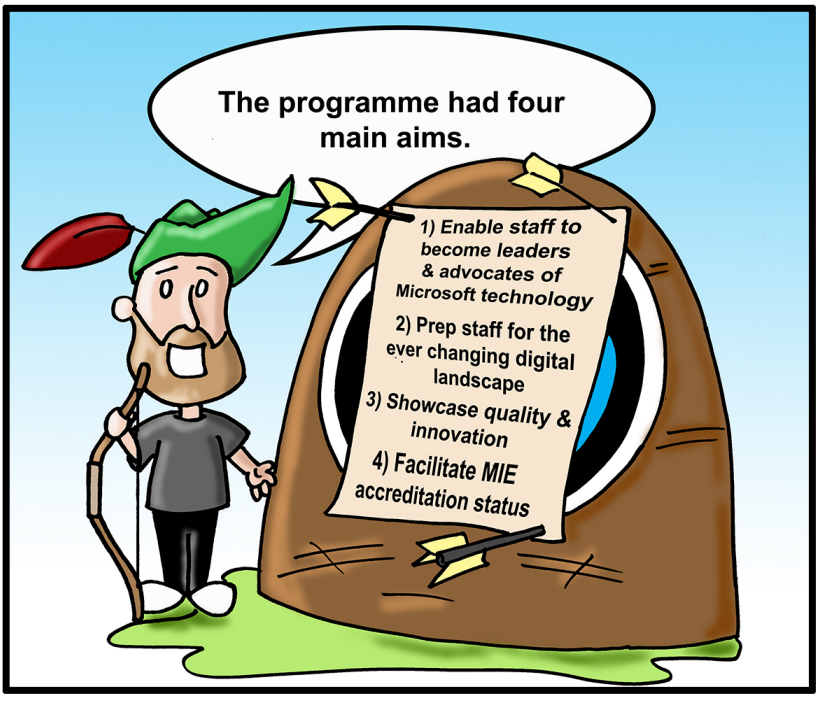
The wider SUMEC aims were:
- Enable staff to become leaders and advocates of Microsoft Technology to enhance teaching and learning by developing digital skills.
- Prepare staff for the changing digital landscape within HE by developing agility and confidence.
- Showcase and measure the innovation and quality of Microsoft facilitated teaching and learning at Staffordshire University.
- Facilitate accreditation, achievement and recognition of skills, namely via the MIE Expert status application, but not limited to this.
Underpinning theoretical framework
The programme structure itself was based on the Salmon (2013) 5 stage model for building online communities of learning or practice in HE. The reason for this is that the SUMEC programme has a focus on HE staff, their community and digital pedagogy and ran entirely online.
Therefore, influenced by this, we designed our own five steps for the SUMEC approach.
- Step 1: the introduction to the programme
- Step 2: sharing of practice and establishing relationships with bespoke and collective synergies
- Step 3: evaluate the use of familiar technologies and practice, whereby coaching teases out new sense making and perspectives
- Step 4: using previous knowledge to explore new technologies and practices with the support of a coach/community
- Step 5: disseminating new ideas, and applying/being accredited with MIEExpert status
Another model that resonates with the SUMEC programme is that of Race (2020) who proposed seven factors of successful learning in HE.
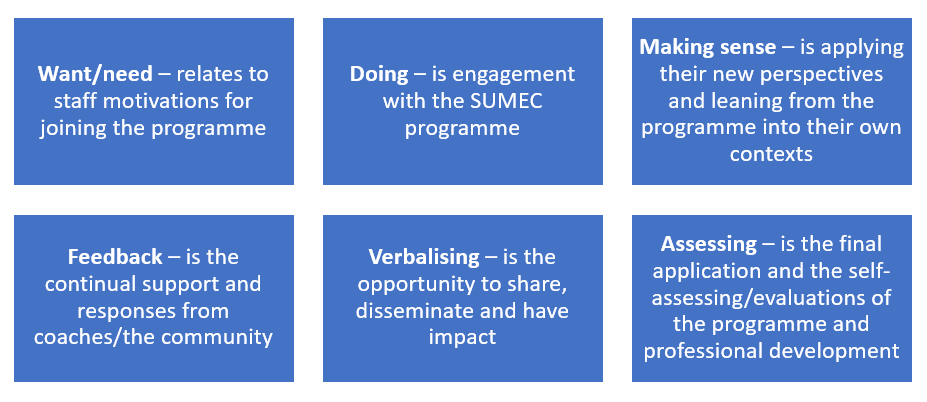
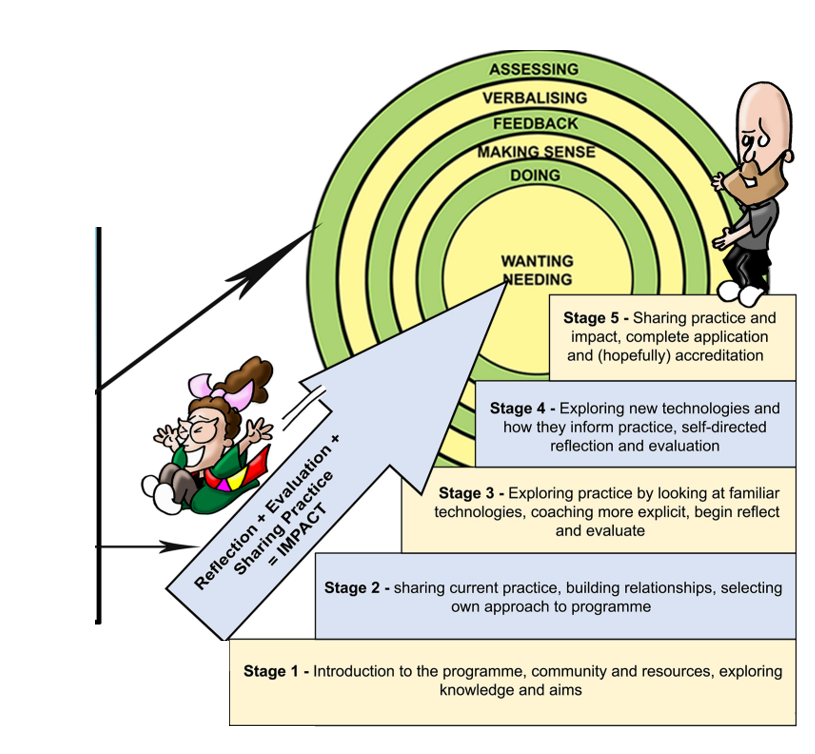
The coaching sessions ran fortnightly, and topics included (but weren’t limited to): a technology buffet – where groups explored and presented on different Microsoft technologies; support with developing teaching resources; nurturing evidence and impact in support of the application. Monthly themes were based upon Keene and Kersznowski (2020) sail the seven cs with Microsoft education and included innovation with collaboration, communication, creativity and computational thinking.
Finally, the programme ended with a SUMEC showcase of all the resources and experiences the community had, had, creating a reusable training resource in itself. For the second iteration the themes were tweaked slightly in response to participants needs, thus in keeping with coaching qualities of personalising the support on offer.

Capturing the Impact of SUMEC
The project used a multiphase mixed methods design, this mixed methods approach involved the SUMEC Community of participants in multiple quantitative and qualitative phases of data collection.
According to Mertens (2009) this can bring about knowledge exchange between researchers and participants and adequately fulfil the project aims. This is particularly the case as coaches and researchers for the SUMEC programme we identified as ‘Insider Researchers’ according to (Tueslner et al 2019) this provides an insightful and reflective approach for conducting research within a setting where the researcher is part of that cultural unit, whilst maintaining their own day-to-day role within that community. We were therefore able to coach staff and run the programme, whilst researching if the programme was fulfilling its aims by carrying out data collection tasks to seek qualitative and quantitavtive responses.
To uphold a continuous exchange of information our data collection methods included a caricature exercise at the start and end of each programme whereby staff identified skills or characteristics MIEExperts have and used these as the basis to reflect upon themselves and their own aspirations. We also conducted self-assessments at the start and end of the programme to measure participants confidence and competence via scaling questions on microsoft technologies. We conducted mid-way and end-point evaluations so staff could feedback on the quality of the programme, leaving time for coaches to respond in real-time practice. We held a SUMEC showcase so the community could present their innovative practice and the recording stored as a reusable learning resoruce and anecdotally fedback on during dissemination. Finally, we totalled how many applied and received Microsoft accreditation at the end of the programme and looked at this against the national backdrop of MIEexperts in represented in HE.
In terms of the sample for project the first iteration of the SUMEC Community included a multi-discipline collaboration across subject areas in the School of Life Sciences and Education at Staffordshire University. 15 colleagues elected themselves to join us following a short 10 minute briefing session. The community included a mix of academics and professional services within the School, with both colleagues who were new to the University and longer-serving members of staff, covering undergraduate and postgraduate teaching, and consisting of a mixture of prior experience in blended, distance or technology enhanced learning. There were no explicit criteria to be fulfilled to be part of the community. The sample therefore was self-elected from Staffordshire University school of Life Sciences and Education. The second iteration was offered more widely around the university following a 10 minute briefing session and opportunity for colleagues to self-elect, this led to 25 colleagues commencing the SUMEC programmes including a diverse mix of researchers, management, academics and professional service staff.
Our Learning
The first cohort saw a 1.8% drop out and the second saw a 3.8% drop out. In terms of retention this is largely positive. Time and workload often impacts on efforts and ability to engage with CPD in higher education. Despite this, all those engaged at the end felt the programme was not onerous. Race (2020) identifies that staying well and managing workload is an important part of a career in HE and being able to provide purposeful learning experiences relies on staff being well. Therefore, it would be in contrast to the aims of SUMEC if staff felt the programme was burdensome or did not feel they could retract from the community for other priorities.
100% of completers agreed that they had achieved what they wanted from the Programme and that it had supported their personal intended development. Their feedback identified that the design, structure, implementation and coaching approach of the programme was a success – with no recommendations given for the programme itself.
According to Gregory and Salmon (2013) incremental innovation coupled with coaching can be a low cost way of upskilling and enhancing digital or online learning in HE and this has resonated with the findings of SUMEC. Feedback has identified that the benefits of SUMEC has enabled staff to fulfil their personal goals and improve their use of technologies for their learners, with the design of the SUMEC programmes explicitly being referred to as a vehicle for that. Therefore, the careful design and influence from Salmon (2013) is important.
93% completing participants agreed that they felt they were part of the SUMEC Community that coaching contributed to personal development, growth and empowerment. When coaching was probed explicitly 93% identified that the coaching presence and non-hierarchical approach enabled confidence to build, was encouraging and enabled personalised/bespoke support. It was noteworthy that the soft skills of the coaches were identified as coming through via this approach such as warmth, empathy, positivity – and were identified as needed when staff were taking risks and innovating in their practice. The combination of a learning technologist and academic creating an effective duo was also noted, with participants highly grateful for the perspectives and skills that brought to the community. This is interesting as perhaps coaching is a skill in its own right, the DFE (2020) signpost to a coaching programme from the OU that states building rapport, listening to learners and supporting reflection are key components to being an effective coach. Whilst the coaches on this programme did not have previous explicit coaching training, the professional backgrounds perhaps leant itself to embodying these skills.
100% of completers that opted to apply for MIEExpert status for accreditation were unanimous that had they not have joined the programme, they would not have applied for MIE Expert status. Race (2020) want/need to join SUMEC beyond Microsoft accreditation were digital skills, community learning, timeliness and passions were motivations for joining the SUMEC programme and feedback was unanimous that individual motivations were each fulfilled.
According to Salmon et al (2019) Scaffolding learning with explicit learner-centredness, having communities that cross-professional and disciplinary areas and starting the learning process with the end in mind’ i.e. future visions and missions, enables programmes of learning to create flexibility and agility for each learner and the collectives community.
Importantly 29 colleagues at Staffordshire University have successfully been admitted to the MIE Expert class of 21-22 and 22-23 due to the SUMEC programme. This means that Staffordshire University has housed most MIE Experts of any University in the UK. Whilst this is small in terms of statistical power, it is notable in terms of HE representation in the national MIE Expert landscape with only 8-9%. Nevertheless, there may also be barriers or something undesirable about becoming an MIE Expert as a means of gaining accreditation and showcasing innovative pedagogy within HE that leaves room to be explored by future research or something which innovators could explore further.
Most pertinent are the approaches to coaching which stood out for the success of this programme, these are transferable to any type of coaching. Therefore, for the future legacy of SUMEC it is proposed that features including coaches being present, positive and warm, empathetic, agile in support and a non-hierarchical relationships with members of the community are adopted in other coaching programmes. Perhaps then SUMEC now stands for Staffordshire Universities Methods of Effective Coaching.
References
Basdogan M., Birdwell T., & Harris T. (2022). Technological frames in classroom: a case study for a faculty professional development. Research in Learning Technology, 30.
Department for Education (2020) Coaching and Mentoring, [Online] Available at Coaching and Mentoring – GOV.UK (www.gov.uk) Last Accessed January 2021
European Mentoring and Coaching Council (2020) Encouraging Excellence for mentors, coaches and supervisors, [Online] Available at: Home (emccuk.org) Last Accessed January 2021
Gregory, J. Salmon, G. (2013) Professional Development for Online University Teaching, Distance Education, October 2013, P.1-14
JISC (2021) Student Digital Experience Insights Survey, [Online] Available at: Student digital experience insights survey 2020/21; UK higher education (HE) survey findings (jisc.ac.uk) Last Accessed January 2021
Keene, B. Kersznowski, K. (2020) Sail the Seven Cs with Microsoft Education, Dave Burgess Consulting, Incorporated: London
Mertens, D. (2009) Transformative Mixed Methods Research, Qualitative Inquiry, vol.16, 6, p.469-474
Race, P. (2020) The Lecturers Toolkit: A Practical Guide to Assessment, Learning and Teaching, Routledge: Milton
Salmon, G. (2013) E-tivities, the key to teaching & learning online. 2nd Edition. Routledge: London
Tueslner, A. (2019) Qualitative Insider Researcher, in, SAGE Research Methods Foundations, SAGE: London
Van Allen J., & Stacy Katz. (2023). Viewing open education within the Technological, Pedagogical, Content Framework: illustrating educator knowledge, skills and dispositions. Research in Learning Technology, 31.


